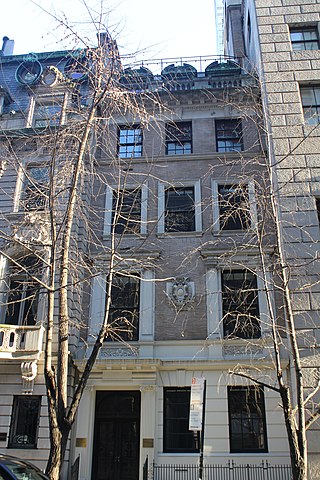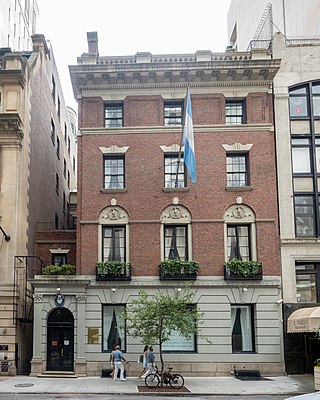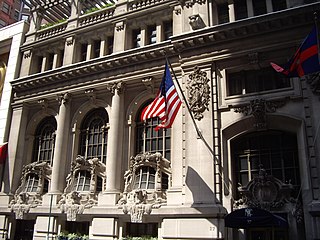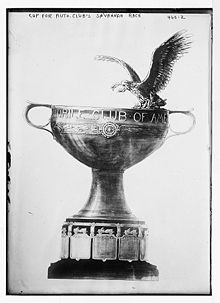
The New York Yacht Club (NYYC) is a private social club and yacht club based in New York City and Newport, Rhode Island. It was founded in 1844 by nine prominent sportsmen. The members have contributed to the sport of yachting and yacht design. As of 2001, the organization was reported to have about 3,000 members. Membership in the club is by invitation only. Its officers include a commodore, vice-commodore, rear-commodore, secretary and treasurer.

The University Club of New York is a private social club at 1 West 54th Street and Fifth Avenue in the Midtown Manhattan neighborhood of New York City. Founded to celebrate the union of social duty and intellectual life, the club was chartered in 1865 for the "promotion of literature and art". The club is not affiliated with any other University Club or college alumni clubs. According to The New York Times, the club is considered one of the most prestigious in New York City.

The 69th Regiment Armory is a historic armory for the U.S. Army National Guard at 68 Lexington Avenue, between East 25th and 26th Streets, in the Rose Hill neighborhood of Manhattan in New York City, United States. Completed in 1906, the armory was designed by the firm of Hunt & Hunt in the Beaux-Arts style. The building is a New York City designated landmark and is listed on the National Register of Historic Places as a National Historic Landmark.

The Royalton Hotel is a hotel at 44 West 44th Street in Midtown Manhattan, New York City, United States. The hotel, opened in 1898, was designed by architecture firm Rossiter & Wright and developed by civil engineer Edward G. Bailey. The 13-story building is made of brick, stone, terracotta, and iron. The hotel's lobby, which connects 43rd and 44th Streets, contains a bar and restaurant. The upper stories originally featured 90 apartments, but these were replaced with 205 guestrooms when Philippe Starck and Gruzen Samton Steinglass Architects converted the Royalton to a boutique hotel in the 1980s.

The Engineering Societies' Building, also known as 25 West 39th Street, is a commercial building at 25–33 West 39th Street in the Midtown Manhattan neighborhood of New York City, United States. Located one block south of Bryant Park, it was constructed in 1907 along with the adjoining Engineers' Club. The building was designed by Herbert D. Hale, of the firm Hale & Rogers, along with Henry G. Morse, in the neo-Renaissance style. It served as the clubhouse of the United Engineering Societies, composed of its three founding societies: the American Society of Mechanical Engineers (ASME), the American Institute of Mining Engineers (AIME), and the American Institute of Electrical Engineers (AIEE). The American Society of Civil Engineers (ASCE) joined the partnership in 1917.

The InterContinental New York Barclay Hotel is a hotel at 111 East 48th Street, on Lexington Avenue between 48th and 49th Streets, in the Midtown Manhattan neighborhood of New York City. The 14-story hotel, operated by IHG Hotels & Resorts, was designed by Cross and Cross in the Colonial style and contains 702 rooms. The Barclay was one of several large hotels developed around Grand Central Terminal as part of Terminal City.

The Peninsula New York is a historic luxury hotel at the corner of Fifth Avenue and 55th Street in the Midtown Manhattan neighborhood of New York City. Built in 1905 as the Gotham Hotel, the structure was designed by Hiss and Weekes in the neoclassical style. The hotel is part of the Peninsula Hotels group, which is owned by Hongkong and Shanghai Hotels (HSH). The structure is 23 stories high and, as of 2022, contains 241 rooms.
5 Columbus Circle is an office building on the southeast corner of Broadway and 58th Street, just south of Columbus Circle, in the Midtown Manhattan neighborhood of New York City, New York, United States. Designed by Carrère and Hastings in the Beaux-Arts style, it is 286 feet (87 m) tall with 20 stories.

218 West 57th Street is a building on 57th Street in Midtown Manhattan in New York City. It was designed by Cyrus L. W. Eidlitz in the French Renaissance Revival style, with an annex built to designs by Eidlitz and Andrew C. McKenzie. The building served as the headquarters of the American Society of Civil Engineers (ASCE) from 1897 to 1917.

The Penn Club of New York is an American 501(c)7 not-for-profit, private social club located on Clubhouse Row in the Midtown Manhattan neighborhood of New York City. The club's 14-story building, which is a designated landmark, is located at 30 West 44th Street and initially was occupied by The Yale Club of New York City.

5 West 54th Street is a commercial building in the Midtown Manhattan neighborhood of New York City. It is along 54th Street's northern sidewalk between Fifth Avenue and Sixth Avenue. The four-story building was designed by R. H. Robertson in the Italian Renaissance Revival style and was constructed between 1897 and 1899 as a private residence. It is the easternmost of five consecutive townhouses erected along the same city block during the 1890s, the others being 7, 11, 13 and 15 West 54th Street. The first floor is clad with rusticated blocks of limestone, while the other floors contain buff-colored brick trimmed with limestone.

12 West 56th Street is a consular building in the Midtown Manhattan neighborhood of New York City, housing the Consulate General of Argentina in New York City. It is along 56th Street's southern sidewalk between Fifth Avenue and Sixth Avenue. The four-and-a-half story building was designed by McKim, Mead & White in the Georgian Revival style. It was constructed between 1899 and 1901 as a private residence, one of several on 56th Street's "Bankers' Row".

30 West 56th Street is a building in the Midtown Manhattan neighborhood of New York City. It is along 56th Street's southern sidewalk between Fifth Avenue and Sixth Avenue. The five-story building was designed by C. P. H. Gilbert in the French Renaissance Revival style. It was constructed between 1899 and 1901 as a private residence, one of several on 56th Street's "Bankers' Row".

12 East 53rd Street, also the Fisk–Harkness House, is a building in the Midtown Manhattan neighborhood of New York City. It is along the south side of 53rd Street between Madison Avenue and Fifth Avenue. The six-story building was designed by Griffith Thomas and was constructed in 1871. It was redesigned in the Tudor-inspired Gothic Revival style in 1906 by Raleigh C. Gildersleeve.

647 Fifth Avenue, originally known as the George W. Vanderbilt Residence, is a commercial building in the Midtown Manhattan neighborhood of New York City. It is along the east side of Fifth Avenue between 51st Street and 52nd Street. The building was designed by Hunt & Hunt as one of the "Marble Twins", a pair of houses at 645 and 647 Fifth Avenue. The houses were constructed between 1902 and 1905 as Vanderbilt family residences. Number 645 was occupied by William B. Osgood Field, while number 647 was owned by George W. Vanderbilt and rented to Robert Wilson Goelet; both were part of the Vanderbilt family by marriage.

The Engineers' Club Building, also known as Bryant Park Place, is a residential building at 32 West 40th Street in the Midtown Manhattan neighborhood of New York City, United States. Located on the southern edge of Bryant Park, it was constructed in 1907 along with the adjoining Engineering Societies' Building. It served as the clubhouse of the Engineers' Club, a social organization formed in 1888. The building was designed by Henry D. Whitfield and Beverly S. King, of the firm Whitfield & King, in the neo-Renaissance style.

The Sofia is a condominium building at the corner of Columbus Avenue and 61st Street on the Upper West Side of Manhattan in New York City. It was constructed from 1929 to 1930 and was designed by the firm of Jardine, Hill & Murdock in the Art Deco style for Kent Automatic Garages. The Sofia is 27 stories tall; the first nine stories above the ground level are used as offices, while the top 17 stories contain residential condominiums. The building is a New York City designated landmark and on the National Register of Historic Places.

The New York Yacht Club Building is a seven-story Beaux-Arts clubhouse at 37 West 44th Street in the Midtown Manhattan neighborhood of New York City. Opened in 1901, the building was designed by architect Whitney Warren of Warren and Wetmore as the sixth clubhouse of the New York Yacht Club (NYYC). The clubhouse is part of Clubhouse Row, a concentration of clubhouses on 44th Street between Fifth and Sixth Avenues. The building is a New York City designated landmark and is listed on the National Register of Historic Places as a National Historic Landmark.

30 West 44th Street is the clubhouse of the Penn Club of New York in the Midtown Manhattan neighborhood of New York City. Designed by architecture firm Tracy and Swartwout in the Beaux-Arts style, the building opened in 1901 as the Yale Club of New York City's clubhouse. The building is part of Clubhouse Row, a concentration of clubhouses on 44th Street between Fifth and Sixth Avenues, and is a New York City designated landmark.

The Chatwal New York, originally the Lambs Club Building, is a hotel and a former clubhouse at 130 West 44th Street, near Times Square, in the Midtown Manhattan neighborhood of New York City. The building was originally six stories high and was developed in two phases as the headquarters of the Lambs, a theatrical social club. The original wing at 128–130 West 44th Street was designed by Stanford White of McKim, Mead & White between 1904 and 1905; the annex at 132 West 44th Street was designed in 1915 by George Freeman. The current design dates to a renovation between 2007 and 2010, designed by Thierry Despont. The building is a New York City designated landmark and is listed on the National Register of Historic Places.




















